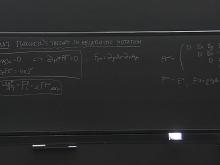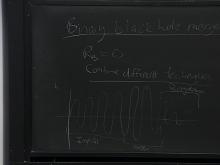Strong Gravity research at Perimeter Institute is devoted to understanding both the theoretical and observational aspects of systems in which gravity is very strong (i.e., spacetime is highly curved or dynamical],. On one hand, this means studying extreme astrophysical systems, like black holes and neutron stars, as well as making and testing predictions for existing and forthcoming gravitational wave detectors, electromagnetic telescopes, and particle astrophysics experiments. On the other hand, it also includes a range of non-astrophysical topics, such as the instabilities of higher-dimensional black holes or the dynamics of strongly-coupled quantum field theories (via holography). The goal of strong gravity researcher is to test the validity of Einstein's theory of gravity, constrain proposed alternatives, understand the most extreme astrophysical systems, and investigate the ways in which highly curved or dynamical spacetimes are linked with a range of other problems in fundamental physics.
Format results
-
8 talks-Collection NumberC19032
Talk
-
PSI 2018/2019 - Strong Field Gravity (East)
15 talks-Collection NumberC19008Talk
-

PSI 2018/2019 - Strong Field Gravity - Lecture 1
William East Perimeter Institute for Theoretical Physics
-

PSI 2018/2019 - Strong Field Gravity - Lecture 2
William East Perimeter Institute for Theoretical Physics
-

-

PSI 2018/2019 - Strong Field Gravity - Lecture 4
William East Perimeter Institute for Theoretical Physics
-

PSI 2018/2019 - Strong Field Gravity - Lecture 5
William East Perimeter Institute for Theoretical Physics
-

PSI 2018/2019 - Strong Field Gravity - Lecture 6
Luis Lehner Perimeter Institute for Theoretical Physics
-

PSI 2018/2019 - Strong Field Gravity - Lecture 7
William East Perimeter Institute for Theoretical Physics
-

PSI 2018/2019 - Strong Field Gravity - Lecture 8
William East Perimeter Institute for Theoretical Physics
-
-
Path to Kilohertz Gravitational-Wave Astronomy
17 talks-Collection NumberC18014Talk
-

-

Hitting the High Notes: The High Frequency Dynamics of Neutron Star Mergers
William East Perimeter Institute for Theoretical Physics
PIRSA:18060045 -

Post-Merger Gravitational Wave Emission
Andreas Bauswein Max Planck Institute for Astrophysics (MPA), Garching
PIRSA:18060046 -

Searching for Ultralight Particles with Gravitational Waves
Masha Baryakhtar University of Washington
PIRSA:18060047 -

3G Detectors, Voyager
Rana Adhikari California Institute of Technology (Caltech) - Division of Physics Mathematics & Astronomy
PIRSA:18060048 -

Discussion Session
PIRSA:18060049 -

Gravitational Wave Telescopes: Some Cosmological Considerations
Latham Boyle University of Edinburgh
PIRSA:18060050 -

Astrophysics and Cosmology with Gravitational-Wave Population Inference
Eric Thrane Monash University - Department of Physics
PIRSA:18060051
-
-
Searching for New Particles with Black Hole Superradiance
11 talks-Collection NumberC18010Talk
-

Searching for Light Bosons with Black Hole Superradiance
Savas Dimopoulos Perimeter Institute for Theoretical Physics
-

Superradiant instabilities and rotating black holes
Sam Dolan University of Southampton
PIRSA:18050028 -

Superradiant instabilities and rotating black holes
Avery Broderick University of Waterloo
-

Measuring Stellar-Mass Black Hole Spins via X-ray Spectroscopy
James Steiner Massachusetts Institute of Technology (MIT)
-

Superradiance Beyond the Linear Regime
Frans Pretorius Princeton University
-

Characterization of compact objects with present and future ground-based gravitational-wave detectors
Salvatore Vitale Massachusetts Institute of Technology (MIT)
-

LIGO and Virgo continuous wave searches - Overview and all-sky searches
keith Riles University of Michigan–Ann Arbor
-

Directed and targeted searches for continuous gravitational waves
Sylvia Zhu Albert Einstein Institute
-
-
Quantum Black Holes in the Sky?
34 talks-Collection NumberC17055Talk
-

Quantifying the evidence for black holes with GW and EM probes
Paolo Pani Instituto Superior Tecnico - Departamento de Física
-

Echoes from the Abyss: Tentative Evidence for Planck-Scale Structure at Black Hole Horizons
Jahed Abedi University of Stavanger (UiS)
-

Improvements on the methods for searching echoes
Julian Westerweck Albert Einstein Institute
-

A model-independent search for gravitational-wave echoes
Archisman Ghosh Institucio Catalana de Recerca I Estudis Avancats (ICREA) - Universitat de Barcelona
-

An alternative significance estimation for the evidence for echoes
Alex Nielsen Albert Einstein Institute
-

Discussion: Evidence for Echoes
PIRSA:17110074 -

Inspiral Tests of Strong-field Gravity and Ringdown Tests of Quantum Black Holes
Kent Yagi University of Virginia
-

A Recipe for Echoes
Aaron Zimmerman The University of Texas at Austin
-
-
PSI 2017/2018 - Relativity (Turok)
15 talks-Collection NumberC17036Talk
-

PSI 2017/2018 - Relativity - Lecture 1
Neil Turok University of Edinburgh
-

PSI 2017/2018 - Relativity - Lecture 2
Neil Turok University of Edinburgh
-

PSI 2017/2018 - Relativity - Lecture 3
Neil Turok University of Edinburgh
-

PSI 2017/2018 - Relativity - Lecture 4
Neil Turok University of Edinburgh
-

PSI 2017/2018 - Relativity - Lecture 5
Neil Turok University of Edinburgh
-

PSI 2017/2018 - Relativity - Lecture 6
Neil Turok University of Edinburgh
-

PSI 2017/2018 - Relativity - Lecture 7
Neil Turok University of Edinburgh
-

PSI 2017/2018 - Relativity - Lecture 8
Neil Turok University of Edinburgh
-
-
PSI 2016/2017 - Relativity (Turok)
14 talks-Collection NumberC16010Talk
-

PSI 2016/2017 - Relativity - Lecture 1
Neil Turok University of Edinburgh
-

PSI 2016/2017 - Relativity - Lecture 2
Neil Turok University of Edinburgh
-

PSI 2016/2017 - Relativity - Lecture 3
Neil Turok University of Edinburgh
-

PSI 2016/2017 - Relativity - Lecture 4
Neil Turok University of Edinburgh
-

PSI 2016/2017 - Relativity - Lecture 5
Neil Turok University of Edinburgh
-

PSI 2016/2017 - Relativity - Lecture 6
Neil Turok University of Edinburgh
-

PSI 2016/2017 - Relativity - Lecture 7
Neil Turok University of Edinburgh
-

-
-
EHT 2014
54 talks-Collection NumberC14041Talk
-

Welcome to Perimeter Institute and the EHT 2014 Conference
Neil Turok University of Edinburgh
-

-

Growth of supermassive black holes and their relationships to their host galaxies
Marta Volonteri Institut d'Astrophysique de Paris
-

Polarized emission from Black Hole Accretion Disks and Jets
Jonathan McKinney University of Maryland, College Park
-

Stellar Orbits at the Galactic Center
Andrea Ghez University of California, Los Angeles
-

-

-

Particle Acceleration and Non-thermal Emission in Radiatively Inefficient Accretion Flows
Eliot Quataert University of California, Berkeley
-
-

-

-

-

Inferring new properties of matter with future gravitational-wave observations
Jocelyn Read California State University, Fullerton
-
PSI 2019/2020 - Classical Physics (Kubiznak)
8 talks-Collection NumberC19032PSI 2019/2020 - Classical Physics (Kubiznak) -
PSI 2018/2019 - Strong Field Gravity (East)
15 talks-Collection NumberC19008PSI 2018/2019 - Strong Field Gravity (East) -
Path to Kilohertz Gravitational-Wave Astronomy
17 talks-Collection NumberC18014We are entering an exponentially growing phase of gravitational-wave (GW) astronomy excitingly represented by the Nobel Prize in Physics last year - only two years after the first detection. The successful multi-messenger detection of binary neutron star merger in last August has triggered increasing interests to probe the neutron star post-merger gravitational radiations as they will give more decisive and informative description of the post-merger object itself and the GW/electromagnetic emission mechanism. As the post-merger GWs mainly lie in the 1kHz-4kHz band it becomes necessary and important to think about possible third-generation GW detectors that are primarily sensitive to the high frequency band. In this workshop we shall focus on possible science case and detector configuration for kHz high-frequency detectors. We will have several invited talks while leaving more time for free discussions. We hope this workshop can serve as a seed for much broader discussions in the GW astronomy community and help promote high frequency detectors as one of the development directions of third-generation GW detectors.
-
Searching for New Particles with Black Hole Superradiance
11 talks-Collection NumberC18010Black hole superradiance is a fascinating process in general relativity and a unique window on ultralight particles beyond the standard model. Bosons -- such as axions and dark photons -- with Compton wavelengths comparable to size of astrophysical black holes grow exponentially to form large clouds spinning down the black hole in the process and produce monochromatic continuous gravitational wave radiation. In the era of gravitational wave astronomy and increasingly sensitive observations of astrophysical black holes and their properties superradiance of new light particles is a promising avenue to search for new physics in regimes inaccessible to terrestrial experiments. This workshop will bring together theorists data analysts and observers in particle physics gravitational wave astronomy strong gravity and high energy astrophysics to explore the signatures of black hole superradiance and to study the current and future possibilities of searching for new particles with black holes.
-
Quantum Black Holes in the Sky?
34 talks-Collection NumberC17055The past decade has witnessed significant breakthroughs in understanding the quantum nature of black holes, with insights coming from quantum information theory, numerical relativity, and string theory. At the same time, astrophysical and gravitational wave observations can now provide an unprecedented window into the phenomenology of black hole horizons. This workshop seeks to bring together leading experts in these fields to explore new theoretical and observational opportunities and synergies that could improve our physical understanding of quantum black holes.
-
PSI 2017/2018 - Relativity (Turok)
15 talks-Collection NumberC17036PSI 2017/2018 - Relativity (Turok) -
PSI 2016/2017 - Relativity (Turok)
14 talks-Collection NumberC16010PSI 2016/2017 - Relativity (Turok) -
-

"Solar Flares From Black Holes: Electromagnetic Signals From Merging Supermassive Binaries"
Sean ResslerThe recent detection of a low frequency gravitational wave background by pulsar timing arrays provides solid evidence that the observable universe contains a population of in-spiralling supermassive black hole binaries. Such binaries likely form as a result of collisions between galaxies and can offer clues as to how black holes and galaxies grow over time. Moreover, since galactic centers are often densely populated by gas and stars, these systems are much more likely to be actively accreting and radiating compared to stellar mass-sized black hole binaries. This makes them promising candidates for multi-messenger detection (combining electromagnetic and gravitational wave information), particularly when LISA comes online or as pulsar timing arrays improve their sensitivity. In order to facilitate this goal, it is important that, in addition to predictions for the possible gravitational wave signals from numerical relativity, we also develop predictions for electromagnetic signals from simulations of black hole binary accretion. In this talk I will present some of our recent results from 3D general relativistic magnetohydrodynamic simulations that utilize a strong-field approximation to the in-spiralling spacetime metric. Specifically, I will showcase several possible distinctive electromagnetic signals from black hole binaries, including quasi-periodic emission, jet precession, and two processes analogous to flaring activity frequently observed in the outer layer of the Sun.
-

Long-term stable non-linear evolutions of ultracompact black hole mimickers
Ultracompact black hole mimickers formed through gravitational collapse under reasonable assumptions obtain light rings in pairs, where one is unstable and the other one is not. Stable light rings are believed to be a potential source for dynamical instability due to the trapping of massless perturbations, as their decay is relatively slow. We study the stability of ultracompact boson stars admitting light rings combining a perturbative analysis with 3+1 numerical-relativity simulations with and without symmetry assumptions. We observe excellent agreement between all perturbative and numerical results which uniformly support the hypothesis that this family of black-hole mimickers is separated into stable and unstable branches by extremal-mass configurations. This separation includes, in particular, thin-shell boson stars with light rings located on the stable branch which we conclude to represent long-term stable black-hole mimickers. Our simulations suggest that the proposed mechanism may not be efficient after all to effectively destroy ultracompact black hole mimickers. -

Regular black holes: from non-linear electrodynamics to pure gravity models
David Kubiznak Charles University
It is well known that (static) regular black hole spacetimes can be sourced by appropriately chosen theories of non-linear electrodynamics. More recently, it was shown that many such models can also be obtained as solutions of vacuum gravity equations, upon considering an infinite series of quasi-topological higher-curvature corrections. After reviewing both these approaches, I will show that the latter construction can be upgraded to yield regular black holes with vanishing inner horizon surface gravity -- a necessary condition for the absence of classical instabilities associated with mass inflation on the inner horizon. I will also comment on singular charged black holes in theories with finite electromagnetic self-energy. -

Inferring new properties of matter with future gravitational-wave observations
Jocelyn Read California State University, Fullerton
As the sensitivity of gravitational-wave detector networks increases, high-fidelity signal recovery from the most prominent events becomes possible. The strongest signals present both opportunities and challenges for determining the properties of their sources. Focusing on the problem of inferring the nuclear equation of state from neutron star mergers, I will discuss how systematic errors from waveform modeling have the potential to dominate the inference of matter properties in near-future observations. If properly addressed, loud signals may reveal subdominant effects on the source dynamics, providing novel opportunities to learn about neutron star matter beyond the equation of state. I will outline a data-driven approach to interpreting gravitational-wave observations with phenomenological signal corrections, including some first results from work at CSUF on binary black hole systems. I’ll also discuss methods for connecting unmodeled waveform effects to the energetics of the source system. Finally, I will relate these uncertainty quantification methods to goals for instrumental design, demonstrating how next-generation sensitivities will translate into improved scientific potential.














